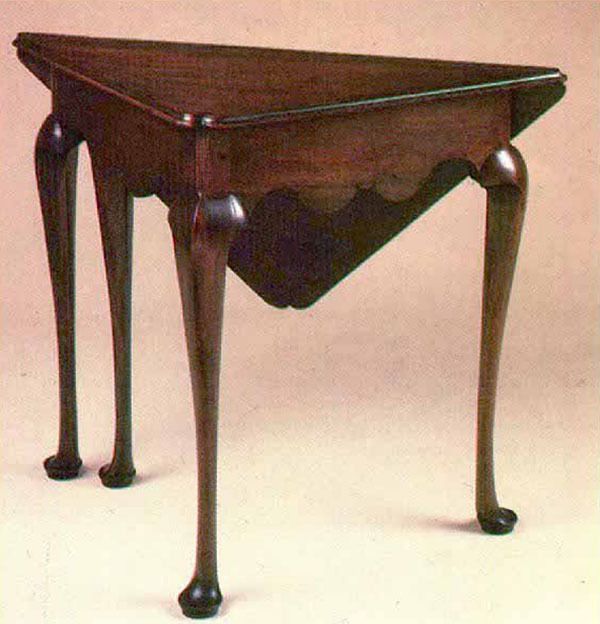Queen Anne Handkerchief Table
Building a three-cornered masterpiece
Synopsis: Eugene Landon copied an extremely rare, beautiful example of a Queen Anne handkerchief table. He made a rubbing of the original tabletop when it was off, so all measurements and proportions are the same as the 1740s original. He suggests making a full-size drawing that includes joinery and wooden-hinge details to clarify the project and help you cut pieces to fit the sizes and angles on the drawing. He explains how to avoid a common mistake: don’t undercut the foot when you bandsaw the curve on the legs. The joinery at the back legs is the interesting part, and the joint where the leaf folds, a nesting rabbet-and-bead, is remarkable, too.
In the middle of a very busy workday about four years ago, the phone rang. It was an elderly acquaintance who lived in a nearby town, calling to inquire whether I would be willing to repair a piece of furniture for her. “It’s a handkerchief table,” she said.
I couldn’t leave what I was working on for a week or so, but agreed to go and look at the table when things slowed down a little. Secretly, I had my doubts about the piece—the handkerchief table is one of the rarest American furniture forms. Perhaps what she had was the larger version, usually called a breakfast table, or perhaps something else entirely. I mused about it for a moment, but almost as soon as I returned to what I had been doing, the table went completely from my mind.
Two years later, out of the blue, I heard the same voice over the phone again: “Mr. Landon, aren’t you interested in my table?” The earlier conversation came back to me instantly, along with a considerable flush of embarrassment. “I’ll be right over,” I said.
When I entered her home, I saw that she knew what she had all right. The little table took my breath away. Even though it was missing the leaf, the hinged leg and all its knee blocks, it had a presence that epitomized pure Queen Anne, before cabinetmakers under the Chippendale influence began to add shells and gingerbread. I have nothing against Chippendale, but while such decoration may sometimes enhance a piece, it may also serve to disguise basic flaws in design.
The little table was so stylistically pure that any such shortcomings would have stood out immediately. As I walked around the piece, I gradually realized that it had no flaws at all; it was perfect.
Much as I dislike extravagant claims, I believe that this handkerchief table is not only excellent Queen Anne, but that it is one of the finest pieces of furniture ever made in any time or place. You simply will not find a shaplier leg, nor one more perfectly proportioned to the rest of the table. The genius of the maker is evident everywhere: The four notched corners of the open top serve to restrain the eye’s travel, yet when the leaf is down, the opened notches blend into a lovely curve. The back of the ankle is undercut just the right amount, the merest touch, to give the entire table poise and an irresistible uplifted energy.
From Fine Woodworking #52
For the full article, download the PDF below:
Fine Woodworking Recommended Products


Blackwing Pencils























Log in or create an account to post a comment.
Sign up Log in